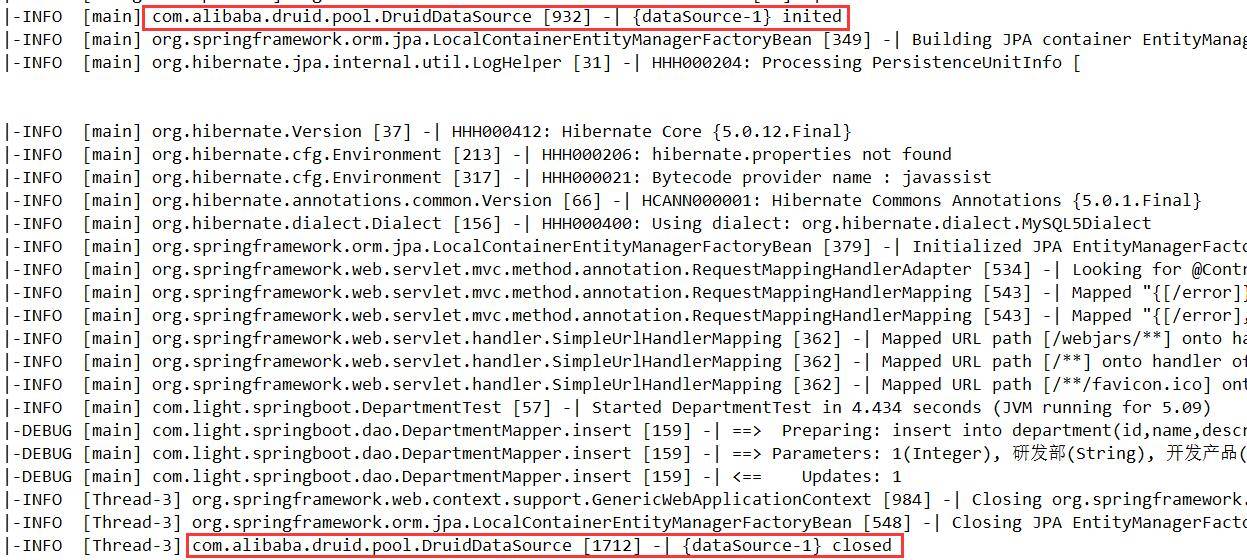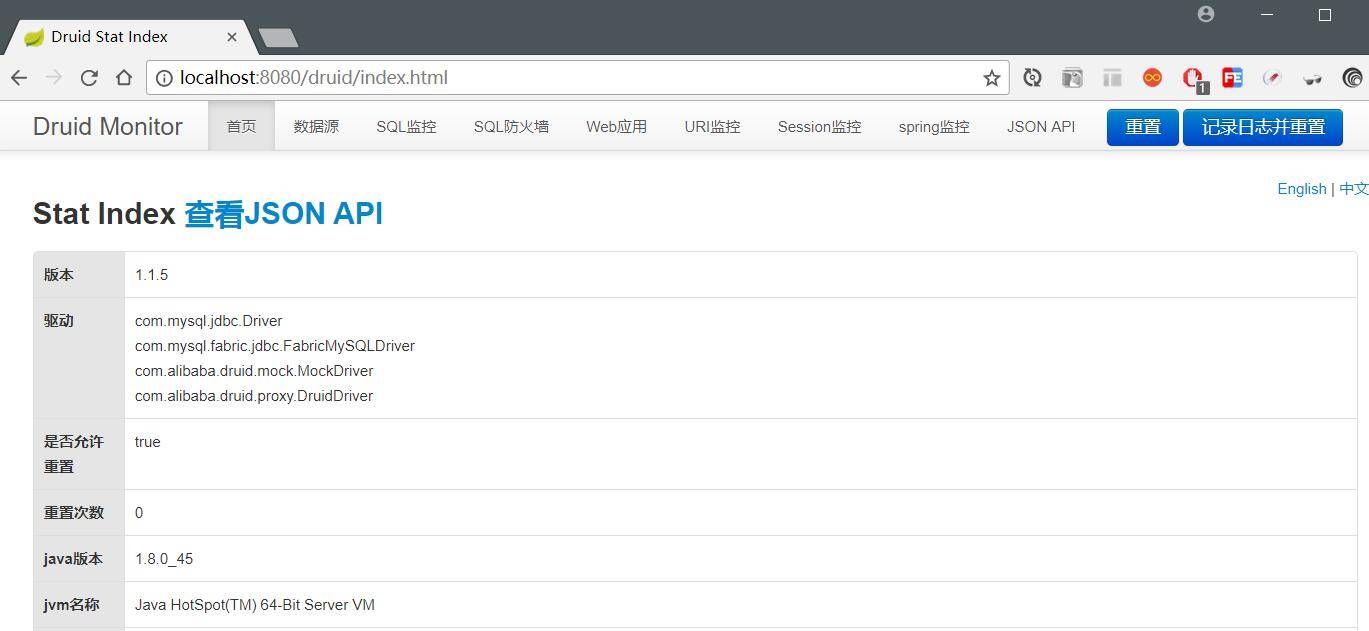Spring Boot 入門之持久層篇(三)
原文地址:Spring Boot 入門之持久層篇(三)
博客地址:http://www.extlight.com
一、前言
上一篇《Spring Boot 入門之 Web 篇(二)》介紹了 Spring Boot 的 Web 開發相關的內容,項目的開發離不開數據,因此本篇開始介紹持久層相關的知識。
二、整合 JdbcTemplate
2.1 添加依賴
<dependency>
<groupId>org.springframework.boot</groupId>
<artifactId>spring-boot-starter-jdbc</artifactId> 2.2 配置數據庫連接
在 application.properties 中添加:
spring.datasource.driver-class-name=com.mysql.jdbc.Driver spring.datasource.url=jdbc:mysql://localhost:3380/springboot?useUnicode=true&characterEncoding=utf8 spring.datasource.username=root spring.datasource.password=tiger
其中,可以不指定 driver-class-name,因為 spring boot 會自動識別 url。
2.3 測試
2.3.1 建表
在 MySQL 中創建名為 springboot 的數據庫,在該庫中創建 user 表:
CREATE TABLE `user` ( `id` INT(11) NOT NULL AUTO_INCREMENT, `username` VARCHAR(50) NOT NULL, `password` VARCHAR(64) NOT NULL, `birthday` DATE NOT NULL, PRIMARY KEY (`id`) ) COLLATE='utf8_general_ci' ENGINE=InnoDB AUTO_INCREMENT=3 ;
2.3.2 建實體類
public class User implements Serializable{
private static final long serialVersionUID = -6249397911566315813L;
private Integer id;
private String username;
private String password;
private Date birthday;
}setter 和 getter 方法此處省略。
2.3.3 dao 接口
接口和實現類如下:
public interface UserDao {
public int insert(User user);
public int deleteById(Integer id);
public int update(User user);
public User getById(Integer id);
}
@Repository
public class UserDaoImpl implements UserDao {
@Autowired
private JdbcTemplate jdbcTemplate;
@Override
public int insert(User user) {
String sql = "insert into user(id,username,password,birthday) values(?,?,?,?)";
return this.jdbcTemplate.update(
sql,
user.getId(),
user.getUsername(),
user.getPassword(),
user.getBirthday()
);
}
@Override
public int deleteById(Integer id) {
String sql = "delete from user where id = ?";
return this.jdbcTemplate.update(sql,id);
}
@Override
public int update(User user) {
String sql = "update user set password = ? where id = ?";
return this.jdbcTemplate.update(
sql,
user.getPassword(),
user.getId()
);
}
@Override
public User getById(Integer id) {
String sql = "select * from user where id = ?";
return this.jdbcTemplate.queryForObject(sql, new RowMapper<User>() {
@Override
public User mapRow(ResultSet rs, int rowNum) throws SQLException {
User user = new User();
user.setId(rs.getInt("id"));
user.setUsername(rs.getString("username"));
user.setPassword(rs.getString("password"));
user.setBirthday(rs.getDate("birthday"));
return user;
}
},id);
}
}2.3.4 測試類:
@RunWith(SpringRunner.class)
@SpringBootTest
public class UserDaoTest {
@Autowired
private UserDao userDao;
@Test
public void testInsert() {
User user = new User();
user.setId(1);
user.setUsername("張三");
user.setPassword("zhangsan");
user.setBirthday(new Date());
int result = this.userDao.insert(user);
System.out.println(result);
}
@Test
public void testGetById() {
User user = this.userDao.getById(1);
System.out.println(user.getUsername());
}
@Test
public void testUpdate() {
User user = new User();
user.setId(1);
user.setPassword("zhangsan123");
this.userDao.update(user);
}
@Test
public void testDeleteById() {
int result = this.userDao.deleteById(1);
System.out.println(result);
}
}測試結果省略...
如需打印日誌,在日誌配置文件中添加如下配置:
<logger name="org.springframework.jdbc.core.JdbcTemplate" level="debug"/>三、整合 Spring-data-jpa
3.1 添加依賴
<dependency>
<groupId>org.springframework.boot</groupId>
<artifactId>spring-boot-starter-data-jpa</artifactId>
</dependency>
<dependency>
<groupId>mysql</groupId>
<artifactId>mysql-connector-java</artifactId>
</dependency>3.2 配置數據庫連接
在 application.properties 中添加:
# 數據庫連接配置
spring.datasource.driver-class-name=com.mysql.jdbc.Driver
spring.datasource.url=jdbc:mysql://localhost:3380/springboot?useUnicode=true&characterEncoding=utf8
spring.datasource.username=root
spring.datasource.password=tiger
# JPA 配置
spring.jpa.hibernate.ddl-auto=update
spring.jpa.show-sql=true3.3 編碼
3.3.1 建表
在 MySQL 中創建名為 springboot 的數據庫,在該庫中創建 role 表:
CREATE TABLE `role` (
`id` INT(11) NOT NULL AUTO_INCREMENT,
`name` VARCHAR(10) NOT NULL,
`descr` VARCHAR(100) NULL DEFAULT NULL,
PRIMARY KEY (`id`)
)
COLLATE='utf8_general_ci'
ENGINE=InnoDB
;註意,主鍵 ID 為 AUTO_INCREMENT 自增。
3.3.2 建實體類
添加相應的註解
@Entity
public class Role implements Serializable{
private static final long serialVersionUID = 3926276668667517847L;
@Id
@GeneratedValue
private Integer id;
@Column
private String name;
@Column
private String descr;
}setter 和 getter 方法此處省略。
3.3.3 Repository 接口
public interface RoleRepository extends JpaRepository<Role, Integer>{
}3.3.4 測試類
@RunWith(SpringRunner.class)
@SpringBootTest
public class RoleRepositoryTest {
@Autowired
private RoleRepository roleRepository;
@Test
public void testInsert() {
Role role = new Role();
role.setName("管理員");
role.setDescr("測試");
Role result = this.roleRepository.save(role);
System.out.println(result);
}
@Test
public void testFindOne() {
Role role = this.roleRepository.findOne(1);
System.out.println(role);
}
@Test
public void testUpdate() {
Role role = new Role();
role.setId(1);
role.setName("管理員");
role.setDescr("控制權限");
Role result = this.roleRepository.save(role);
System.out.println(result);
}
@Test
public void testDelete() {
this.roleRepository.delete(1);
}
}測試結果省略...
四、整合 Mybatis
整合 MyBatis 有兩種方式:
1) 使用 mybatis 官方提供的 Spring Boot 整合包實現。
2) 使用 mybatis-spring 整合的方式,也就是傳統的方式(推薦,此方式容易控制 MyBatis 的配置)。
4.1 配置依賴
方式一:
添加依賴:
<!-- mybatis -->
<dependency>
<groupId>org.mybatis.spring.boot</groupId>
<artifactId>mybatis-spring-boot-starter</artifactId>
<version>1.3.0</version>
</dependency>
<!-- mysql 驅動包 -->
<dependency>
<groupId>mysql</groupId>
<artifactId>mysql-connector-java</artifactId>
</dependency>配置數據庫連接:
在 application.properties 中添加:
# 數據源配置
spring.datasource.driver-class-name=com.mysql.jdbc.Driver
spring.datasource.url=jdbc:mysql://localhost:3380/springboot?useUnicode=true&characterEncoding=utf8
spring.datasource.username=root
spring.datasource.password=tiger
# mybatis 配置
mybatis.config-location=classpath:mybatis/mybatis-config.xml
mybatis.mapper-locations=classpath:mybatis/mapper/*.xml方式二:
添加依賴:
<dependency>
<groupId>org.mybatis</groupId>
<artifactId>mybatis</artifactId>
<version>3.4.4</version>
</dependency>
<dependency>
<groupId>org.mybatis</groupId>
<artifactId>mybatis-spring</artifactId>
<version>1.3.1</version>
</dependency>創建配置類:
@Configuration
public class MyBatisConfiguration {
@Bean
@ConditionalOnMissingBean // 當容器裏沒有指定的 Bean 的情況下創建該對象
public SqlSessionFactoryBean sqlSessionFactory(DataSource dataSource) {
SqlSessionFactoryBean sqlSessionFactoryBean = new SqlSessionFactoryBean();
// 設置數據源
sqlSessionFactoryBean.setDataSource(dataSource);
// 設置mybatis的主配置文件
ResourcePatternResolver resolver = new PathMatchingResourcePatternResolver();
Resource mybatisConfigXml = resolver.getResource("classpath:mybatis/mybatis-config.xml");
sqlSessionFactoryBean.setConfigLocation(mybatisConfigXml);
// 設置mapper映射文件
Resource[] mapperXml;
try {
mapperXml = resolver.getResources("classpath:mybatis/mapper/*.xml");
sqlSessionFactoryBean.setMapperLocations(mapperXml);
} catch (IOException e) {
e.printStackTrace();
}
// 設置別名包
//sqlSessionFactoryBean.setTypeAliasesPackage("com.light.domain");
return sqlSessionFactoryBean;
}
@Bean
@ConditionalOnBean(SqlSessionFactoryBean.class) // 當 SqlSessionFactoryBean 實例存在時創建對象
public MapperScannerConfigurer mapperScannerConfigurer() {
MapperScannerConfigurer mapperScannerConfigurer = new MapperScannerConfigurer();
mapperScannerConfigurer.setBasePackage("com.light.dao");
return mapperScannerConfigurer;
}
}此方式也需要在 applicaton.properties 配置數據庫連接,當不需要在文件中配置 mybatis 相關參數。
以上便是兩種方式的配置的不同之處。
在 src/main/resources 下創建 mybatis 文件夾,並在 mybatis 文件夾中創建 "mybatis-config.xml" 配置文件,內容如下:
<?xml version="1.0" encoding="UTF-8"?>
<!DOCTYPE configuration
PUBLIC "-//mybatis.org//DTD Config 3.0//EN"
"http://mybatis.org/dtd/mybatis-3-config.dtd">
<configuration>
<typeAliases>
</typeAliases>
</configuration>mybatis 文件夾下再創建一個 "mapper" 文件夾,裏邊存放 Mpper 接口對應的 mapper 映射文件。
4.2 測試
4.2.1 建表
在 MySQL 中創建名為 springboot 的數據庫,在該庫中創建 role 表:
CREATE TABLE `department` (
`id` INT(11) NOT NULL,
`name` VARCHAR(10) NOT NULL,
`descr` VARCHAR(50) NULL DEFAULT NULL,
PRIMARY KEY (`id`)
)
ENGINE=InnoDB
;
4.2.2 實體類
public class Department implements Serializable{
private static final long serialVersionUID = 6067283535977178571L;
private Integer id;
private String name;
private String descr;
}setet 和 getter 方法省略。
4.2.3 Mapper 接口
@Mapper
public interface DepartmentMapper {
public void insert(Department department);
public Department getById(Integer id);
public void update(Department department);
public void deleteById(Integer id);
}mybatis/mapper/departmentMapper.xml :
<?xml version="1.0" encoding="UTF-8"?>
<!DOCTYPE mapper PUBLIC "-//mybatis.org//DTD Mapper 3.0//EN"
"http://mybatis.org/dtd/mybatis-3-mapper.dtd">
<mapper namespace="com.light.springboot.dao.DepartmentMapper">
<insert id="insert" parameterType="com.light.springboot.domain.Department">
insert into department(id,name,descr) values(#{id},#{name},#{descr})
</insert>
<select id="getById" parameterType="java.lang.Integer" resultType="com.light.springboot.domain.Department">
select id,name,descr from department where id = #{id}
</select>
<update id="update" parameterType="com.light.springboot.domain.Department">
update department set descr = #{descr} where id = #{id}
</update>
<delete id="deleteById" parameterType="java.lang.Integer">
delete from department where id = #{id}
</delete>
</mapper>4.2.4 測試類
@RunWith(SpringRunner.class)
@SpringBootTest
public class DepartmentTest {
@Autowired
private DepartmentMapper departmentMapper;
@Test
public void testInsert() {
Department department = new Department();
department.setId(1);
department.setName("研發部");
department.setDescr("開發產品");
this.departmentMapper.insert(department);
}
@Test
public void testGetById() {
Department department = this.departmentMapper.getById(1);
System.out.println(department);
}
@Test
public void testUpdate() {
Department department = new Department();
department.setId(1);
department.setDescr("開發高級產品");
this.departmentMapper.update(department);
}
@Test
public void testDeleteById() {
this.departmentMapper.deleteById(1);
}
}測試結果省略...
五、配置 Druid 數據源
5.1 添加依賴
<dependency>
<groupId>com.alibaba</groupId>
<artifactId>druid-spring-boot-starter</artifactId>
<version>1.1.5</version>
</dependency>5.2 添加配置
在 application.properties 中添加:
spring.datasource.driver-class-name=com.mysql.jdbc.Driver
spring.datasource.url=jdbc:mysql://localhost:3380/springboot?useUnicode=true&characterEncoding=utf8
spring.datasource.username=root
spring.datasource.password=tiger
# 修改數據源
spring.datasource.type=com.alibaba.druid.pool.DruidDataSource
spring.datasource.druid.initial-size=5
spring.datasource.druid.min-idle=5
spring.datasource.druid.max-active=20
spring.datasource.druid.max-wait=60000
spring.datasource.druid.time-between-eviction-runs-millis=60000
spring.datasource.druid.min-evictable-idle-time-millis=300000
spring.datasource.druid.validation-query=SELECT 1 FROM DUAL
spring.datasource.druid.test-while-idle=true
spring.datasource.druid.test-on-borrow=false
spring.datasource.druid.test-on-return=false
spring.datasource.druid.pool-prepared-statements=true
spring.datasource.druid.max-pool-prepared-statement-per-connection-size=20
spring.datasource.druid.filters=stat,wall,log4j 通過上文 MyBatis 的測試代碼,運行結果如下:

項目已經使用了 Druid 數據源了。
六、配置 Druid 監控
默認情況下,Druid 的監控統計功能和頁面是開啟的。
我們啟動項目,訪問 http://localhost:8080/druid/index.html,如下圖:

為了保證訪問的安全性,我們可以如下配置:
在 application.properties 中添加:
## druid 監控
spring.datasource.druid.web-stat-filter.enabled=true
spring.datasource.druid.web-stat-filter.url-pattern=/*
spring.datasource.druid.web-stat-filter.exclusions=*.js,*.gif,*.jpg,*.png,*.css,*.ico,/druid/*
## druid 監控頁面
spring.datasource.druid.stat-view-servlet.enabled=true
spring.datasource.druid.stat-view-servlet.url-pattern=/druid/*
spring.datasource.druid.stat-view-servlet.login-username=druid
spring.datasource.druid.stat-view-servlet.login-password=druid123重啟項目,再次訪問 http://localhost:8080/druid/index.html 地址時需要身份驗證:

七、參考資料
- https://github.com/alibaba/druid/tree/master/druid-spring-boot-starter Druid 相關
Spring Boot 入門之持久層篇(三)
